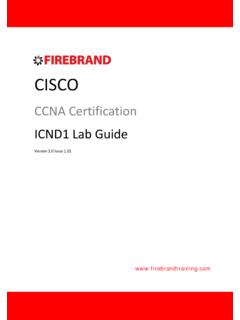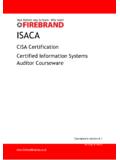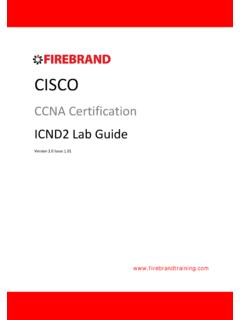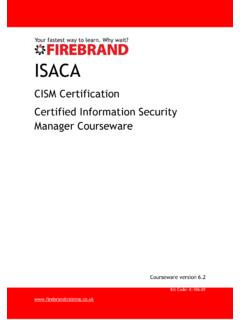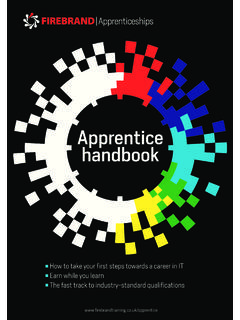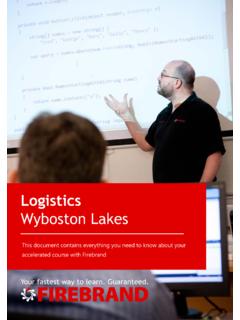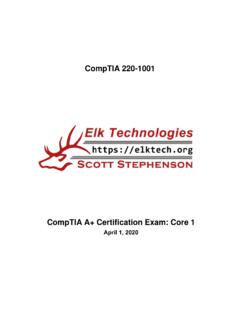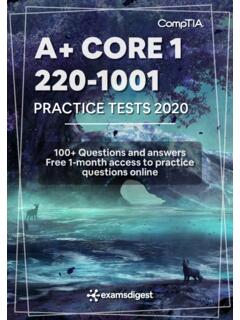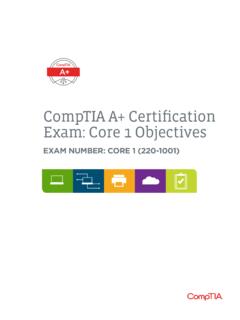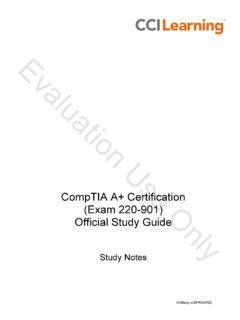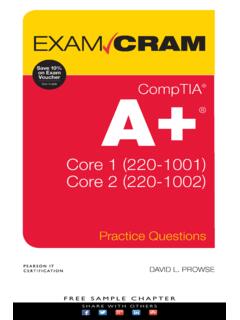Transcription of CompTIA A+ Certification Exam: Core 2 Objectives
1 CompTIA A+ Certification Exam: core 2 Objectives EXAM NUMBER: core 2 (220-1002). About the Exam Candidates are encouraged to use this document to help prepare for CompTIA A+ core 2. In order to receive the CompTIA A+ Certification , you must pass two exams : core 1 (220- 1001) and core 2 (220-1002). CompTIA A+ core 2 measures the necessary skills for an entry- level IT professional. Successful candidates will have the knowledge required to: Assemble components based on customer requirements Install, configure, and maintain PCs, mobile devices, and software for end users Understand the basics of networking and security forensics Properly and safely diagnose, resolve, and document common hardware and software issues Apply troubleshooting skills Provide appropriate customer support Understand the basics of scripting, virtualization, desktop imaging, and deployment These content examples are meant to clarify the test Objectives and should not be construed as a comprehensive listing of all the content of this examination.
2 EXAM ACCREDITATION. CompTIA A+ is accredited by ANSI to show compliance with the ISO 17024 Standard and, as such, undergoes regular reviews and updates to the exam Objectives . EXAM DEVELOPMENT. CompTIA exams result from subject matter expert workshops and industry-wide survey results regarding the skills and knowledge required of an entry-level IT professional. CompTIA AUTHORIZED MATERIALS USE POLICY. CompTIA certifications , LLC is not affiliated with and does not authorize, endorse or condone utilizing any content provided by unauthorized third-party training sites (aka brain dumps ). Individuals who utilize such materials in preparation for any CompTIA examination will have their certifications revoked and be suspended from future testing in accordance with the CompTIA Candidate Agreement. In an effort to more clearly communicate CompTIA 's exam policies on use of unauthorized study materials, CompTIA directs all Certification candidates to the CompTIA Certification Exam Policies.
3 Please review all CompTIA policies before beginning the study process for any CompTIA exam. Candidates will be required to abide by the CompTIA Candidate Agreement. If a candidate has a question as to whether study materials are considered unauthorized (aka brain dumps ), he/she should contact CompTIA at to confirm. PLEASE NOTE. The lists of examples provided in bulleted format are not exhaustive lists. Other examples of technologies, processes, or tasks pertaining to each objective may also be included on the exam although not listed or covered in this Objectives document. CompTIA is constantly reviewing the content of our exams and updating test questions to be sure our exams are current and the security of the questions is protected. When necessary, we will publish updated exams based on testing exam Objectives . Please know that all related exam preparation materials will still be valid. CompTIA A+ Certification Exam: core 2 Objectives Version (Exam Number: core 2). TEST DETAILS.
4 Required exam core 2. Number of questions Maximum of 90. Types of questions Multiple choice and performance-based Length of test 90 minutes Recommended experience 12 months of experience as an IT support specialist Passing score 700 (on a scale of 100 900). EXAM Objectives (DOMAINS). The table below lists the domains measured by this examination and the extent to which they are represented: DOMAIN PERCENTAGE OF EXAMINATION. Operating Systems 27%. Security 24%. Software Troubleshooting 26%. Operational Procedures 23%. Total 100%. CompTIA A+ Certification Exam: core 2 Objectives Version (Exam Number: core 2). Operating Systems Compare and contrast common operating system types and their purposes. 32-bit vs. 64-bit Cell phone/tablet operating systems Compatibility concerns - RAM limitations - Microsoft Windows between operating systems - Software compatibility - Android Workstation operating systems - iOS. - Microsoft Windows - Chrome OS. - Apple Macintosh OS Vendor-specific limitations - Linux - End-of-life - Update limitations Compare and contrast features of Microsoft Windows versions.
5 Windows 7 Corporate vs. personal needs - Branchcache Windows 8 - Domain access - EFS. Windows - Bitlocker Desktop styles/user interface Windows 10 - Media center Summarize general OS installation considerations and upgrade methods. Boot methods - Image deployment - ext3, ext4. - USB - Recovery partition - HFS. - CD-ROM - Refresh/restore - Swap partition - DVD Partitioning - Quick format vs. full format - PXE - Dynamic Load alternate third-party - Solid state/flash drives - Basic drivers when necessary - Netboot - Primary Workgroup vs. Domain setup - External/hot-swappable drive - Extended Time/date/region/language settings - Internal hard drive (partition) - Logical Driver installation, software, Type of installations - GPT and Windows updates - Unattended installation File system types/formatting Factory recovery partition - In-place upgrade - ExFAT Properly formatted boot drive with - Clean install - FAT32 the correct partitions/format - Repair installation - NTFS Prerequisites/hardware compatibility - Multiboot - CDFS Application compatibility - Remote network installation - NFS OS compatibility/upgrade path CompTIA A+ Certification Exam: core 2 Objectives Version (Exam Number: core 2).
6 Operating Systems Given a scenario, use appropriate Microsoft command line tools. Navigation shutdown copy - dir dism xcopy - cd sfc robocopy - .. chkdsk net use ipconfig diskpart net user ping taskkill [command name] /? tracert gpupdate Commands available with standard netstat gpresult privileges vs. administrative privileges nslookup format Given a scenario, use Microsoft operating system features and tools. Administrative MSConfig - Shrink partitions - Computer Management - General - Assigning/changing drive letters - Device Manager - Boot - Adding drives - Local Users and Groups - Services - Adding arrays - Local Security Policy - Startup - Storage spaces - Performance Monitor - Tools System utilities - Services Task Manager - Regedit - System Configuration - Applications - Command - Task Scheduler - Processes - - Component Services - Performance - MMC. - Data Sources - Networking - MSTSC. - Print Management - Users - Notepad - Windows Memory Diagnostics Disk Management - Explorer - Windows Firewall - Drive status - Msinfo32.
7 - Advanced Security - Mounting - DxDiag - Event Viewer - Initializing - Disk Defragmenter - User Account Management - Extending partitions - System Restore - Splitting partitions - Windows Update Given a scenario, use Microsoft Windows Control Panel utilities. Internet Options Folder Options - Sleep/suspend - Connections - View hidden files - Standby - Security - Hide extensions Credential Manager - General - General options Programs and features - Privacy - View options HomeGroup - Programs System Devices and Printers - Advanced - Performance (virtual memory) Sound Display/Display Settings - Remote settings Troubleshooting - Resolution - System protection Network and Sharing Center - Color depth Windows Firewall Device Manager - Refresh rate Power Options Bitlocker User Accounts - Hibernate Sync Center - Power plans CompTIA A+ Certification Exam: core 2 Objectives Version (Exam Number: core 2). Operating Systems Summarize application installation and configuration concepts. System requirements Methods of installation and deployment Security considerations - Drive space - Local (CD/USB) - Impact to device - RAM - Network-based - Impact to network OS requirements Local user permissions - Compatibility - Folder/file access for installation Given a scenario, configure Microsoft Windows networking on a client/desktop.
8 HomeGroup vs. Workgroup Proxy settings - DNS. Domain setup Remote Desktop Connection - Gateway Network shares/administrative Remote Assistance Network card properties shares/mapping drives Home vs. Work vs. Public network settings - Half duplex/full duplex/auto Printer sharing vs. network Firewall settings - Speed printer mapping - Exceptions - Wake-on-LAN. Establish networking connections - Configuration - QoS. - VPN - Enabling/disabling Windows Firewall - BIOS (on-board NIC). - Dial-ups Configuring an alternative - Wireless IP address in Windows - Wired - IP addressing - WWAN (Cellular) - Subnet mask Given a scenario, use features and tools of the Mac OS. and Linux client/desktop operating systems. Best practices Features - pwd vs. passwd - Scheduled backups - Multiple desktops/Mission Control - mv - Scheduled disk maintenance - Key Chain - cp - System updates/App Store - Spot Light - rm - Patch management - iCloud - chmod - Driver/firmware updates - Gestures - chown - Antivirus/Anti-malware updates - Finder - iwconfig/ifconfig Tools - Remote Disc - ps - Backup/Time Machine - Dock - su/sudo - Restore/Snapshot - Boot Camp - apt-get - Image recovery Basic Linux commands - vi - Disk maintenance utilities - ls - dd - Shell/Terminal - grep - kill - Screen sharing - cd - Force Quit - shutdown CompTIA A+ Certification Exam: core 2 Objectives Version (Exam Number: core 2).
9 Security Summarize the importance of physical security measures. Mantrap Biometric locks Privacy screen Badge reader Hardware tokens Key fobs Smart card Cable locks Entry control roster Security guard Server locks Door lock USB locks Explain logical security concepts. Active Directory MDM policies Directory permissions - Login script Port security VPN. - Domain MAC address filtering DLP. - Group Policy/Updates Certificates Access control lists - Organizational Units Antivirus/Anti-malware Smart card - Home Folder Firewalls Email filtering - Folder redirection User authentication/strong passwords Trusted/untrusted software sources Software tokens Multifactor authentication Principle of least privilege Compare and contrast wireless security protocols and authentication methods. Protocols and encryption Authentication - WEP - Single-factor - WPA - Multifactor - WPA2 - RADIUS. - TKIP - TACACS. - AES. Given a scenario, detect, remove, and prevent malware using appropriate tools and methods.
10 Malware - Botnet - Recovery console - Ransomware - Worm - Backup/restore - Trojan - Spyware - End user education - Keylogger Tools and methods - Software firewalls - Rootkit - Antivirus - SecureDNS. - Virus - Anti-malware CompTIA A+ Certification Exam: core 2 Objectives Version (Exam Number: core 2). Security Compare and contrast social engineering, threats, and vulnerabilities. Social engineering DDoS Spoofing - Phishing DoS Non-compliant systems - Spear phishing Zero-day Zombie - Impersonation Man-in-the-middle - Shoulder surfing Brute force - Tailgating Dictionary - Dumpster diving Rainbow table Compare and contrast the differences of basic Microsoft Windows OS security settings. User and groups - Moving vs. copying folders and files User authentication - Administrator - File attributes - Single sign-on - Power user Shared files and folders Run as administrator vs. standard user - Guest - Administrative shares vs. local shares BitLocker - Standard user - Permission propagation BitLocker To Go NTFS vs.
